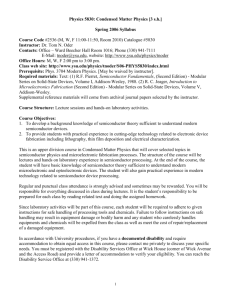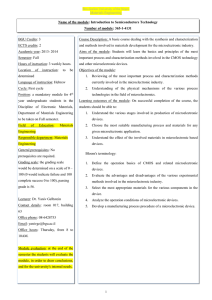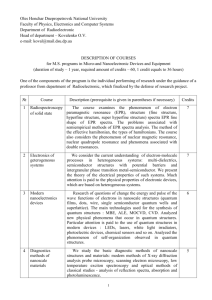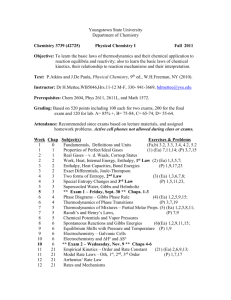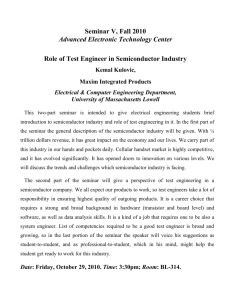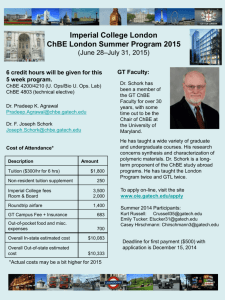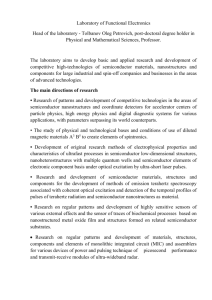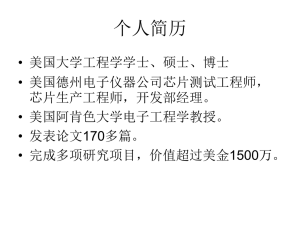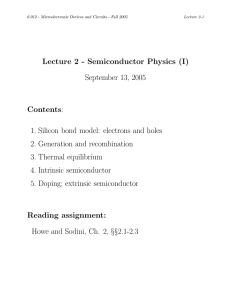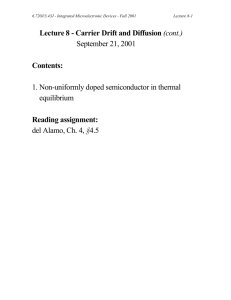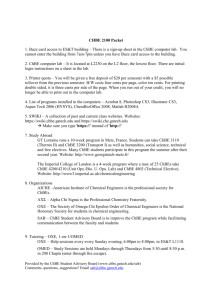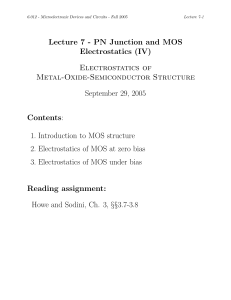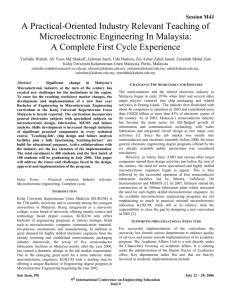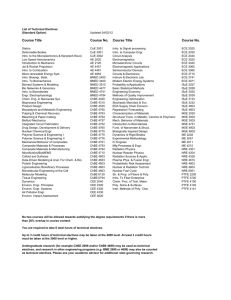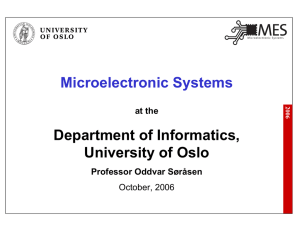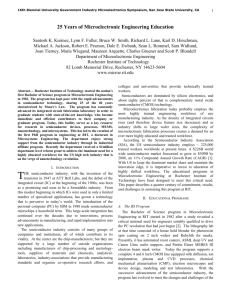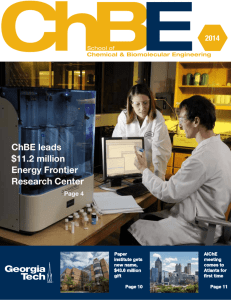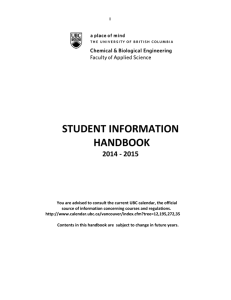Course: ChE 396A - "Microelectronics Processing for
advertisement
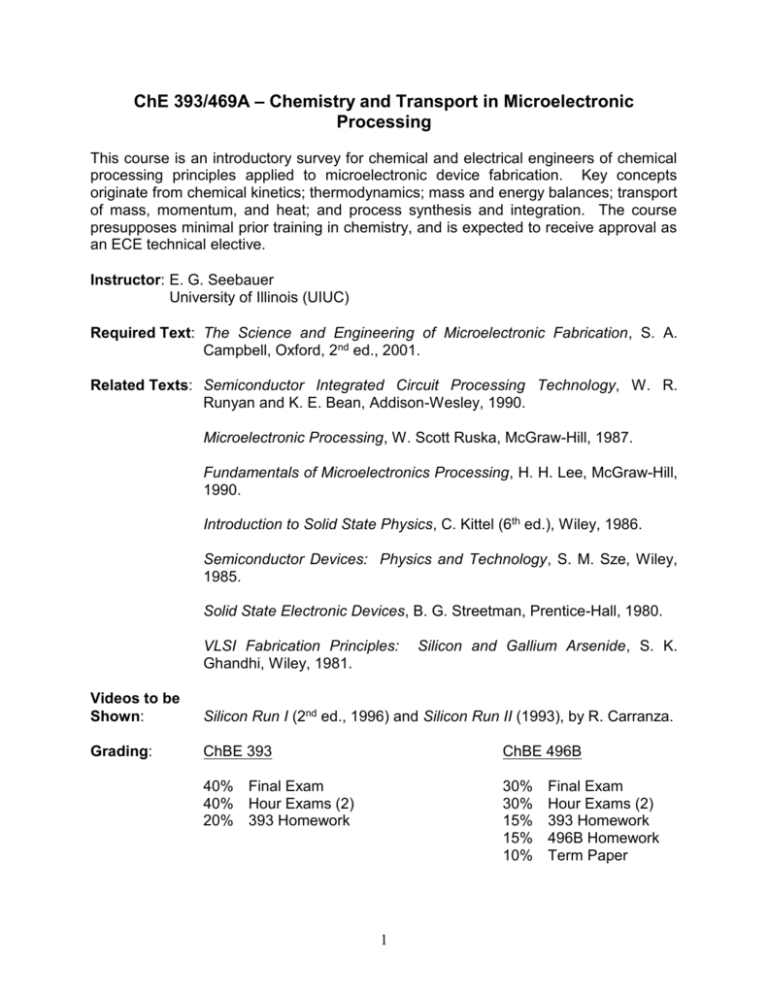
ChE 393/469A – Chemistry and Transport in Microelectronic Processing This course is an introductory survey for chemical and electrical engineers of chemical processing principles applied to microelectronic device fabrication. Key concepts originate from chemical kinetics; thermodynamics; mass and energy balances; transport of mass, momentum, and heat; and process synthesis and integration. The course presupposes minimal prior training in chemistry, and is expected to receive approval as an ECE technical elective. Instructor: E. G. Seebauer University of Illinois (UIUC) Required Text: The Science and Engineering of Microelectronic Fabrication, S. A. Campbell, Oxford, 2nd ed., 2001. Related Texts: Semiconductor Integrated Circuit Processing Technology, W. R. Runyan and K. E. Bean, Addison-Wesley, 1990. Microelectronic Processing, W. Scott Ruska, McGraw-Hill, 1987. Fundamentals of Microelectronics Processing, H. H. Lee, McGraw-Hill, 1990. Introduction to Solid State Physics, C. Kittel (6th ed.), Wiley, 1986. Semiconductor Devices: Physics and Technology, S. M. Sze, Wiley, 1985. Solid State Electronic Devices, B. G. Streetman, Prentice-Hall, 1980. VLSI Fabrication Principles: Ghandhi, Wiley, 1981. Silicon and Gallium Arsenide, S. K. Videos to be Shown: Silicon Run I (2nd ed., 1996) and Silicon Run II (1993), by R. Carranza. Grading: ChBE 393 ChBE 496B 40% Final Exam 40% Hour Exams (2) 20% 393 Homework 30% 30% 15% 15% 10% 1 Final Exam Hour Exams (2) 393 Homework 496B Homework Term Paper Homework Policies: 1. TA’s are also graduate students with many responsibilities that require careful scheduling. It is difficult to fit grading into that schedule when homework submissions dribble in after the due date. Moreover, sometimes homework solutions may be discussed in class on the due date. Hence, homework is due at the beginning of class on Thursday. Exceptions are possible in unusual cases if permission is granted prior to class. Homework received within 24 hours of the due date will receive only 1/4 credit. After that, the homework will receive no credit. 2. Grading homework accurately and fairly is a difficult task that is greatly complicated by illegible writing and other forms of messiness. Therefore, please be neat. In particular, please write on one side of the paper, staple your papers together, and avoid tearing the paper out of spiral notebooks. If the final answer to a homework problem is numerical, please identify your answer clearly by boxing or highlighting it in some way. The TA is authorized to deduct points for failure to observe these rules of homework etiquette. 3. Arriving at homework solutions through study groups can be a very effective way to learn. However, a key goal of the course is to ensure that certain concepts take root in every student’s head. Merely copying or paraphrasing another someone else’s work does not permit that process to happen. Thus, your paper must make a convincing case that the solution has come from your own head. There should be no appearance of copying or paraphrasing others’ work, either from this year or previous years. Permitting your own work to be copied or paraphrased also offends against this principle. Because this principle is so important, consequences for failing to observe it are likely to be severe. 4. You may find it necessary to be absent from class due to plant trips or other reasons. However, the first concern of a student enrolled in school must be for schoolwork. Hence, travel should not be scheduled to conflict with important dates in the syllabus, such as exams and the Microelectronics Lab tour. The dates for exams and tour are shown on the following page. No make-ups will be allowed for travel reasons. Also, if you must be gone when homework is due, it is still your responsibility to see that it is handed in on time. 2 ChBE 393/469A Course Schedule Lect. No. 1 2 3 4 5 6 7 8 9 10 11 12 13 14 15 16 17 18 Topics Underlying Concepts Industry history SIA Roadmap Semiconductor materials Semiconductor physics pn junctions Field effects Lithography Overall perspective Reading in Campbell Ch.1, FEOL video Solid state physics Notes Optics Etching (wet) Buffers Electrochemistry Plasma phenomena Plasma phenomena Sputtering physics Process control Ch. 7.1, 7.3-7.6, 8.1-8.6 Ch. 11.1 Etching (dry) Etching (dry) Physical vapor deposition Rapid thermal processing Hour Exam 1 Microelec. Lab Tour Chemical vapor deposition Rate selectivity Process control Si oxidation 19 20 Si refining 21 Czochralski growth 22 Hour Exam 2 Diffusional doping 23 Diffusional doping 24 25 Ion implantation Transient enhanced diffusion Packaging 26 Factory-level issues Surface kinetics Kinetics/gas transport Boundary layers Case study: TiSi2 Rate-limiting steps Diffusion-rxn (differential mass balances, 1-D) Well-stirred reactors Differential mass balances on distributions Separations by crystallization Differential energy balances (1-D) Ch. 13.1-13.4 Defect thermodynamics Transient diffusion equations Defect thermodynamics Transient diffusion equations Implantation physics Diffusion-rxn (3-D PDE’s) Electrochemistry 1-D heat transfer Process integration Ch. 3.1-3.5 BEOL video FINAL EXAM: One week following the final lecture. 3 Ch. 11.3-11.7 Ch. 11.3-11.7 Ch. 12.1-12.7, 12.10-12.11, 12.13 Notes, Ch. 6.2-6.3 Ch. 4.1-4.4, 4.6 Notes Ch. 2.4-2.8 Ch. 3.1-3.5 Ch. 5.1, 5.6 Notes Notes
